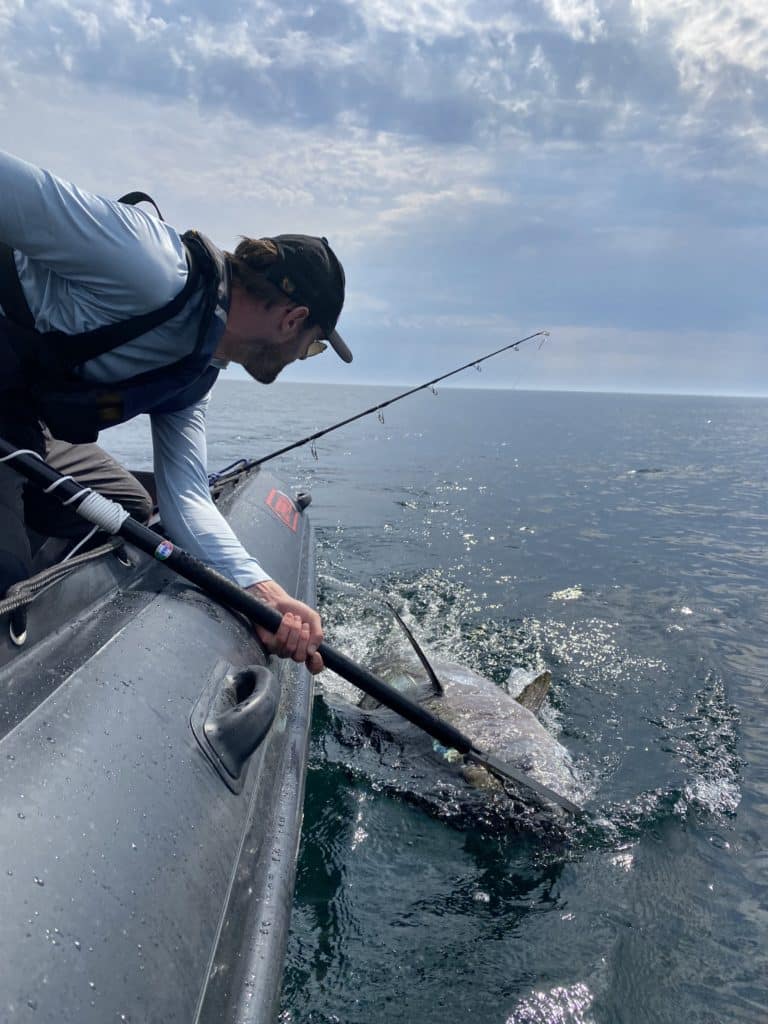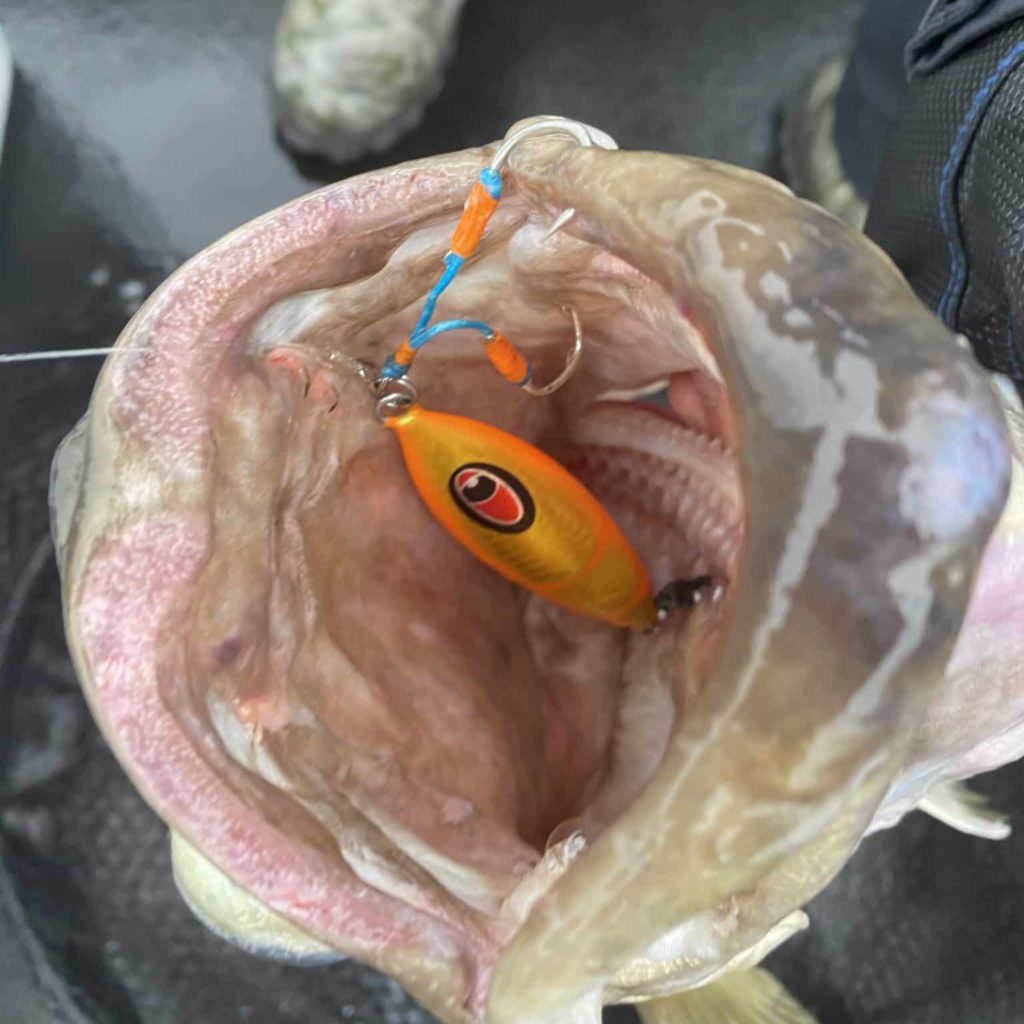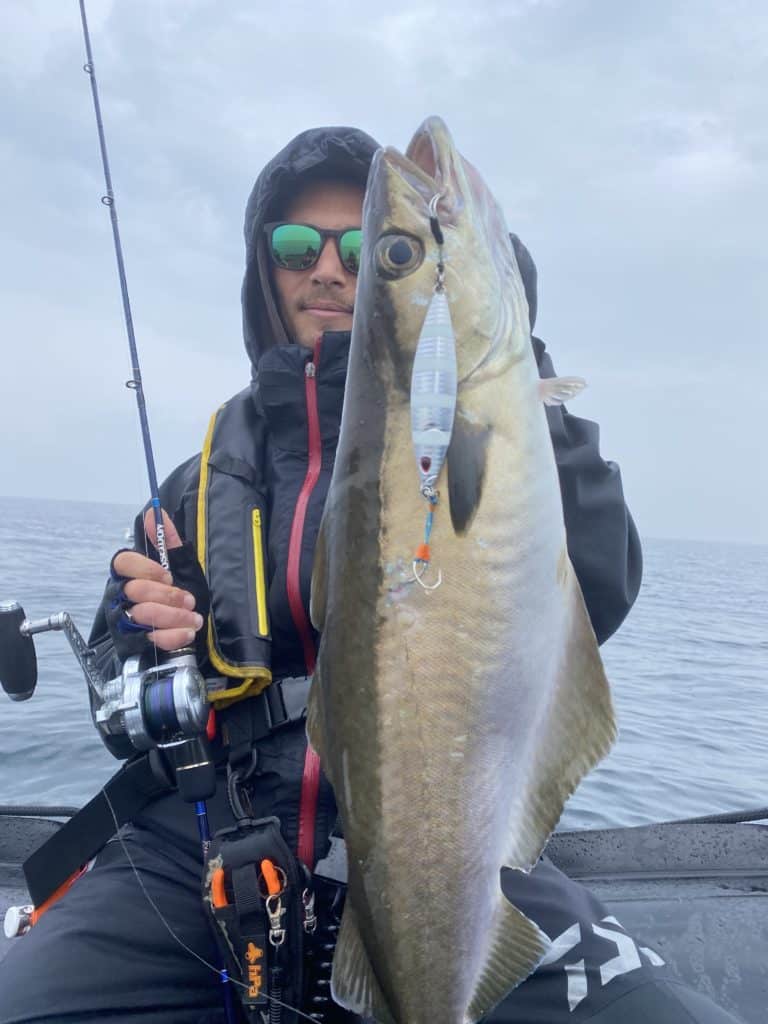Bluefin tuna lures in Brittany, suitable equipment
The bluefin tuna is without doubt the most powerful fish to be found on our coasts, and for good reason our Breton waters are home to some of the largest specimens on the French coastline. The average size is exceptional, with fish over 1.80 metres in length not uncommon and record specimens weighing in at over 200 kilos. Its lure fishing on the hunt is without doubt one of the most exciting.
Faced with fish of this size, it is essential to use suitable equipment that will both shorten the fight so that you can practise no-kill in good conditions and keep the angler safe. It is strongly recommended that you seek the help of a professional or an association to tackle this type of fishing, which is difficult to access and even dangerous without prior experience.
The aim of this article is to help you choose the right equipment from the outset, without racking your brains. Setting off with a good foundation will save you time and money.
Equipment adapted to the search for this giant of the oceans in Brittany
First of all, as far as the rod is concerned, we'll adapt our choice to the weight of the fish we're after. For example, to get the upper hand on fish weighing in excess of 100 kilos, without getting into the big debate about LB power, we'll start from the premise that you need, at the very least, a rod capable of supporting a PE 10 line and a reel drag in excess of 15 kilos at a 45-degree rod angle. It's the first piece of information you'll find on any rod.
Next, we adapt the rod to the angler's height and weight. If you're going to fight successfully, you'll need to adjust your weight and centre of gravity. Buying a good rod for bluefin tuna fishing is no small investment, so I urge you to visit a specialist shop as far as possible. It also has the added advantage of keeping the trade alive, allowing you to choose a cane action that suits your needs and to talk to experienced professionals. If you are light or inexperienced, a rod with a more progressive (softer) action will allow you to play with your weight more easily and will be more forgiving of angle errors during the fight. On the other hand, if you are heavier (over 80 kilos), a faster-action rod will enable you to get the upper hand on the fish quickly and bring the fight to a successful conclusion more quickly.

As a general rule, choose a rod no longer than 2.30 m. I personally prefer 2.20m rods. The shorter the rod, the less painful the fight will be for the angler and the greater the pressure exerted on the fish.
Note that there's no point in going for the most powerful rod possible straight away, but being able to withstand a prolonged fight with a 14-15 kg rod is already an achievement in itself.
Finally, ideally you should choose a rod with a tip that is supple enough to propel medium-sized lures at good distances when hunting (generally between 60 and 120 g), but above all with precision. Precision is one of the most important factors in the success of your fishing action, so this will considerably increase your chances of success.
As you can see, it's all about compromise, but many people dwell too much on this last point. Choose a rod capable of bringing the fish back to the boat quickly and in good conditions as a priority, even if this is at the expense of casting distance.
It's better to have one or two bites a day and bring the fish back to the boat than to have ten and break every time, or worse, to spend long hours fighting, which will considerably reduce the fish's chances of survival...
Choosing the right reel is relatively straightforward, as we're coming up to the extreme limits of what a Spinning package can handle. So I would recommend that you go straight to the top end of the market, or even the very top end (depending on your budget, of course). The mid-range is still an option, but with a more limited lifespan. Particular attention should be paid to the progressive braking action.

For this type of fishing, the weight of the rod and reel is of little importance. Given the small number of casts you make in a day, this factor will have little impact, so it's best to go for an 18,000 or 20,000 size reel straight away.
The harness, absolutely essential for this type of fishing. For my part, I opted for low-position harnesses that reduce the load on the angler and help maintain good posture during the fight.
As far as the braid is concerned, a well-made braid that is as round as possible is not too much - it is as important as the rod for obtaining good casting distances and is all too often the weak link.
Finally, a good Shock leader (minimum 200 LB) to prevent premature breakage due to the wear of the leader on the teeth of the fish, as well as repeated tail strokes on the upper part of the line which can easily weaken it, a bit of small tackle and a few lures you can trust and you're all set, at least as far as the fishing action is concerned.
A forthcoming article on handling the fish once it reaches the boat will follow in the coming weeks. Stay connected!
This article reports on my experiences and the equipment I have chosen as a result. Everyone is free to adapt their equipment according to their needs and experience.
Slow Pitch Jigging or Slow Jigging
As its name suggests, slow jigging is a slower technique than traditional jigging, requiring less effort and using lighter tackle.
The advantage of this technique lies in its versatility, making it possible to target a large number of fish species, at different depths and in most conditions. When used correctly, it can be a formidable tool, particularly when fish activity is low or when you are approaching areas subject to heavy fishing pressure.
The use of asymmetrically shaped Jigs, with more flicker than traditional Jigs and combined with minimalist animations perfectly vertical to the boat, will allow us to work longer and more efficiently on a restricted area. This will often have the effect of triggering hits where other techniques have failed. The main idea of this technique is to really become aware of the movements of the Jig through the water column as a function of drift and depth.
From there, the possibilities for the angler are numerous: you can vary the weight, the shape of the jig and the animation until you find the right combination that will make the fish react. It's this constant search that makes fishing so complex and interesting.
From Japan to Brittany
To be able to practice this technique, which comes to us from Japan, in the rules of the art, we need to use a Bait-Casting set which will allow us to work the fish with the reel only. The very parabolic action of this rod is used solely for jig animation and striking.
With the basics of the technique out of the way, this article gives you a summary of what has worked for me and my trainees over the years, more specifically in the coastal areas of Brittany. I won't go into other sectors in this article. It can be used as a basis for beginners who want to get started, or as a refresher for trainees who have come to learn on the job. It does not apply to other playing fields, but provides feedback on a given area.
Slow jigging encompasses three disciplines (the word pitch refers to the action of animating the jig):
- the high pitch
- the long fall
- the slow pitch.
They can be translated as: high animation, long descent, and slow animation.

It's the latter that we're interested in first, as it's the most suited to our Breton waters and our fish species. That's something I've come to realise after several years of practice in the Finistère area, and that's just me. Once again, it's up to you to adapt the technique to suit your fishing experience and sector. There's no shortage of documentation on the subject, but it's often too detailed and indigestible for the novice angler.
For the slow pitch, the animation is obtained by the action of the reel synchronised with the movement of the rod. A series of short pulls of 10 to 20 cm executed at a slow pace combined with the retrieve of the reel at a rate of 1/2 to 1/8 of a turn of the crank per animation constitutes the basis of the "slow pitch" animation, it's up to you to vary until you find the winning animation of the day.
Thanks to the very progressive action of the rod and the centre of gravity of the Jig, which is positioned at different points depending on the model, the Jig will rise vertically during the animation phase before slowly dropping back down as it flutters. To achieve this effect, the angler will have to accompany the line during the descent phase while maintaining a slight tension. This is where 70 per cent of the bites occur and it is this very special action that allows the Jig to fish longer and therefore increase the chances of a fish becoming interested in it.
This will allow us to work the Jig methodically in stages through the water column where the species we are looking for is supposed to be held. It will be interesting to prospect in 5 to 10 metre stages to find the depth at which the fish are held. Here again, the use of a high-performance echo sounder will save time.
Specific equipment
We're now going to take a look at the slow jigging equipment suitable for inshore fishing in Brittany, which will enable us to fish at depths ranging from 20 to 100 metres on average.

We use specific "slow jigging" rods, usually between 1m80 and 1m90 in length. The most versatile power is 50-150g for the mains. Depending on the area and the current, Jigs weighing more than 200 grams can be used in certain situations, in which case the power of the rod should be adapted.
The reel: it's best to go for a reel with a round profile dedicated to this purpose. It should be strong enough to support the weight of the Jigs and have a good capacity. Sizes vary from brand to brand. My preference is for reels without line guides, as they allow the line to be reeled in properly and eliminate the 'line rubbing' factor on the line guide roller. This is a non-negligible advantage that will maximise the resistance of the line. The reel must be capable of returning at least 90 cm per turn of the crank.
For the braid, we prefer a graduated braid (multicoloured braid), to know the depth at which we will move the Jig. We'll also opt for a braid with the smallest possible diameter (PE1 to PE1.5 as a general rule) because it will generate less resistance in the water and allow us to fish vertically, which is essential for slow-pitch fishing.
For the leader, use fluorocarbon at a length of 4 to 8 m. The sizes I use most are 16, 20 and 25 LB.
Choose a few jigs of different profiles and sizes with varying degrees of glide (jig shapes vary greatly from brand to brand), and in a range of weights to cater for all situations. The rule of thumb is to double the weight according to the fishing depth. In 40 metres of water, start by using an 80-gram Jig before adapting the weight according to the result obtained, bearing in mind the verticality of the line. The ideal way to start is to go from 20 g to 20 g to make an initial selection of Jigs: 60 g, 80 g, 100 g, 120 g, 140 g, 160 g.
As far as hooks are concerned, Jigs should be fitted with Assits Hook (two single hooks connected by a braid which is attached to the Jig by means of a broken ring), which unlike treble hooks will not restrict the lure's swimming action and will accentuate the action of the Jig. The hooks should be relatively thin to compensate for the lack of rigidity of the rods due to their very parabolic action and to ensure good penetration of the hook during the striking action.

I recommend starting with a single set of Assists Hook at the head of the Jig to limit snags on the bottom and the loss of lures. If you find that you're having a few misfires on the hook, you can then add a second set of Assists at the rear of the Jig. Note that for best efficiency the hooks should meet in the centre of the Jig without overlapping (this will give you an idea of how long your Assists should be depending on the Jigs used).
To get the best possible action, the slow jigs must be connected to the line by a fixed point. Swivels should be avoided, and a combination of a broken ring and a welded ring should be used so that you can change the jig quickly to suit the conditions.
An article detailing the animation phases and movements of the different types of Jigs will follow.
Boarding the After Tax
The After-Tax is a 6.10 m Zeppelin 20V pro Commander RIB designed entirely for sport fishing. Clear deck layout, plenty of rod holders and suitable electronics.
This boat, made in France, is also classified as unsinkable, a guarantee of safety. Very wide and deep, this boat is very seaworthy. The shape of her hull makes her comfortable even in rough seas! Its low seat height and wide hypallon flanges make it stable, comfortable and safe, whether you're fishing or sailing.
The boat is powered by a Suzuki 4-stroke 150hp engine, regularly serviced at our dealership. The reputation of this ensemble is well established.

On-board electronics and safety
Our boat is equipped with a Helix 10 SHIRP SI depth sounder and two probes built into the flaps - simple, high-performance, robust electronics.
For your safety, the boat is also equipped with a fixed VHF 'RT 1050' and a long-range antenna. It has two batteries and a coupler, a portable VHF in case of need, a liferaft, recent and serviced automatic lifejackets and safety equipment that complies with current regulations.
The top-of-the-range equipment you'll be provided with is recent and well-maintained, so there are no nasty surprises. I work mainly with the DAIWA brand, and the quality of the equipment offered by this brand is well established. What's more, the wide choice in their catalogue means you can carry the right equipment for every fishing technique.





